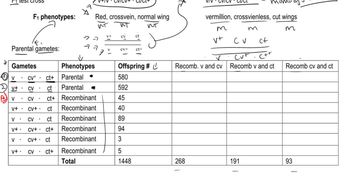The Drosophila homeotic mutation spineless aristapedia (ssᵃ) results in the formation of a miniature tarsal structure (normally part of the leg) on the end of the antenna. What insight is provided by (ssᵃ) concerning the role of genes during determination?
Table of contents
- 1. Introduction to Genetics51m
- 2. Mendel's Laws of Inheritance3h 37m
- 3. Extensions to Mendelian Inheritance2h 41m
- 4. Genetic Mapping and Linkage2h 28m
- 5. Genetics of Bacteria and Viruses1h 21m
- 6. Chromosomal Variation1h 48m
- 7. DNA and Chromosome Structure56m
- 8. DNA Replication1h 10m
- 9. Mitosis and Meiosis1h 34m
- 10. Transcription1h 0m
- 11. Translation58m
- 12. Gene Regulation in Prokaryotes1h 19m
- 13. Gene Regulation in Eukaryotes44m
- 14. Genetic Control of Development44m
- 15. Genomes and Genomics1h 50m
- 16. Transposable Elements47m
- 17. Mutation, Repair, and Recombination1h 6m
- 18. Molecular Genetic Tools19m
- 19. Cancer Genetics29m
- 20. Quantitative Genetics1h 26m
- 21. Population Genetics50m
- 22. Evolutionary Genetics29m
14. Genetic Control of Development
Developmental Patterning Genes
Problem 15
Textbook Question
The specification of the anterior–posterior axis in Drosophila embryos is initially controlled by various gene products that are synthesized and stored in the mature egg following oogenesis. Mutations in these genes result in abnormalities of the axis during embryogenesis. These mutations illustrate maternal effect. How do such mutations vary from those produced by organelle heredity? Devise a set of parallel crosses and expected outcomes involving mutant genes that contrast maternal effect and organelle heredity.
 Verified step by step guidance
Verified step by step guidance1
Understand the concept of maternal effect: Maternal effect refers to the phenomenon where the phenotype of the offspring is determined by the genotype of the mother, due to gene products deposited in the egg during oogenesis. These gene products influence early embryonic development, such as the anterior-posterior axis specification in Drosophila.
Understand organelle heredity: Organelle heredity involves the inheritance of genetic material from organelles such as mitochondria or chloroplasts. This type of inheritance is non-Mendelian and typically maternal, as organelles are passed to offspring through the cytoplasm of the egg.
Devise parallel crosses for maternal effect: For maternal effect, cross a homozygous mutant female (e.g., for a gene affecting axis specification) with a wild-type male. The offspring will exhibit the mutant phenotype regardless of their own genotype, as the mother's genotype determines the phenotype.
Devise parallel crosses for organelle heredity: For organelle heredity, cross a female with mutant organelle DNA (e.g., mitochondrial mutation) with a wild-type male. The offspring will inherit the mutant organelle DNA and exhibit the mutant phenotype, as organelle DNA is maternally inherited.
Compare expected outcomes: In maternal effect, the offspring's phenotype is determined by the mother's genotype, not their own. In organelle heredity, the offspring's phenotype is determined by the organelle DNA inherited from the mother. These mechanisms differ in the source of the genetic material influencing the phenotype.
 Verified video answer for a similar problem:
Verified video answer for a similar problem:This video solution was recommended by our tutors as helpful for the problem above
Video duration:
2mPlay a video:
Was this helpful?
Key Concepts
Here are the essential concepts you must grasp in order to answer the question correctly.
Maternal Effect Genes
Maternal effect genes are genes expressed in the mother that produce products (like RNA or proteins) that are deposited into the egg during oogenesis. These products influence the development of the embryo, particularly in establishing body axes. Mutations in these genes can lead to developmental defects in the offspring, regardless of the genotype of the offspring, as they rely on maternal contributions for early development.
Recommended video:
Guided course

Maternal Effect
Organelle Heredity
Organelle heredity refers to the inheritance of traits determined by genes located in organelles, such as mitochondria or chloroplasts, rather than nuclear DNA. This type of inheritance is often maternal, as organelles are typically passed down from the mother’s egg. Mutations in organelle DNA can lead to specific phenotypic traits, but these traits are inherited differently than those influenced by maternal effect genes, as they depend on the organelle's genetic material.
Recommended video:
Guided course

Organelle Inheritance
Genetic Crosses
Genetic crosses are experimental methods used to study inheritance patterns by mating individuals with known genotypes. In the context of maternal effect and organelle heredity, parallel crosses can be devised to observe the outcomes of offspring from parents with mutations in maternal effect genes versus those with mutations in organelle genes. By analyzing the phenotypes of the offspring, researchers can distinguish the effects of maternal contributions from those of organelle inheritance.
Recommended video:
Guided course

Trihybrid Cross
Related Videos
Related Practice
Textbook Question
386
views


